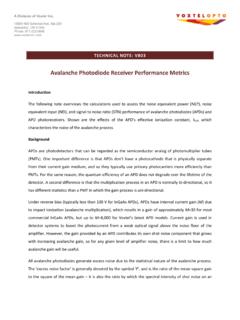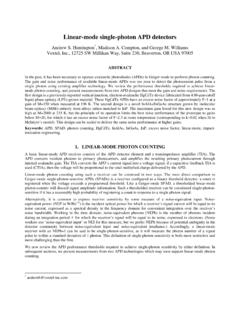Transcription of Probabilistic analysis of Linear Mode vs Geiger …
1 SPIE Defense and Security Symposium Manuscript 6220-8 Probabilistic analysis of Linear Mode vs Geiger Mode APD FPAs for advanced ladar enabled interceptors George M. Williams and Andrew S. Huntington Voxtel, Inc., 12725 SW Millikan Way, Suite 230, Beaverton, OR, USA 97005-1782 ABSTRACT To meet evolving ballistic missile threats, advanced seekers will include a multi-modal imaging capability in which a passive single- or multi-band infrared focal plane array (FPA) shares a common aperture with an active laser radar ( ladar ) receiver likely, a photon-counting ladar receiver that can resolve photon times of arrival with sub-nanosecond resolution. The overall success of such a system will depend upon its photon detection efficiency and sensitivity to upset by spurious detection events.
2 In the past, to perform photon counting functions, it has generally been necessary to operate near infrared (NIR) avalanche photodiode (APD) FPAs in Geiger Mode. Linear Mode APDs could not provide enough proportional gain with sufficiently low noise to make the photocurrent from a single photon detectible using existing amplifier technology. However, recent improvements in APDs, sub-micron CMOS technology, and concomitant amplifier designs, have made Linear Mode single-photon-counting APDs (SPADs) possible. We analyze the potential benefits of a ladar receiver based on Linear Mode SPADs, which include: 1) the ability to obtain range information from more than one object in a pixel s instantaneous-field-of-view (IFOV), 2) a lower false alarm rate, 3) the ability to detect targets behind debris, 4) an advantage in the endgame, when stronger reflected signals allow dark current rejection via thresholding, and 5) the ability to record signal intensity, which can be used to increase kill efficiency.
3 As expected, multiple laser shots of the same scene improves the target detection probability. Keywords: THAAD, laser radar, ladar , missile seeker, missile defense, single photon counting, avalanche photodiode, APD 1. INTRODUCTION Hit-to-kill missile interceptors are a major component of the United States missile defense strategy (Figure 1). The task of hypersonic interception requires a robust kill vehicle with a highly capable seeker. To address emerging threats, advanced seekers must have the ability to track multiple closely spaced objects (CSOs), cope with countermeasures, and perform mission critical target discrimination functions in a cluttered battlespace (Figure 2). The effectiveness of current generation hit-to-kill defensive weapons with single-color passive IR seekers can be improved upon by adding an active ladar The addition of a high-resolution 3-D imaging Figure 1: A representative BMDS weapon system.
4 Courtesy of Missile Defense Agency: SPIE Defense and Security Symposium Manuscript 6220-8 capability improves the seeker s ability to collect data about a threat cloud s structure and the flight characteristics of its components. In this manner, dual-mode seeker architectures reduce BMD seeker systems vulnerability to foreseeable countermeasures. For seeker applications, ladar FPAs based upon Geiger Mode SPADs have been Additionally, Linear Mode SPADs are being developed3 that show considerable promise over their Geiger Mode counterparts for BMD seeker applications. Here, we are interested in providing an analysis of the performance differences between the two types of APD-based ladar receiver. Our analysis builds upon a heuristic overview of hit-to-kill missile defense in the 21st Century as presented by LaCroix and Kurzius,4 which serves as a useful platform for sensor tradeoff analysis .
5 Employment of the seeker In general, a missile defense system interconnects an assembly of sensors and weapons. The sensors include space-based passive IR imagers that detect launches, ground-based tracking radar, and both passive and active imagers on the weapons themselves. In a typical operational scenario for an upper tier missile defense system, the enemy ballistic missile launch is detected by an overhead sensor which cues the missile defense system. Interception of the warhead in its re-entry vehicle (RV) is attempted following burnout of its motor. During this time, the RV moves on an approximately parabolic path with an apogee of up to several hundred The warhead is accompanied on this trajectory by decoys and debris, which complicate identification of the warhead within the threat cloud (see Figure 2).
6 Since the distance between the ground-based fire control radar and the threat cloud is long, objects within the threat cloud cannot be adequately resolved by radar alone. However, the trajectory of the threat cloud can be projected from radar data, permitting commitment of interceptors and prediction of the threat s impact point. The command, control, battle management and communications (C2 BMC) element of the missile defense system directs one or more interceptors to engage the threat at a point on its trajectory well away from the estimated impact point. The interceptor is initially directed to the threat cloud by ground-based radar. However, imperfect guidance of the interceptor as well as radar tracking errors cause the kill vehicle (KV) to be released within a roughly spherical zone of uncertainty in the vicinity of the threat called the handover basket.
7 Within the handover basket, it is the role of the KV s seeker to autonomously detect the target within the threat cloud against the background of space, and maneuver to correct the error in the KV s intercept trajectory. Various systematic errors conspire to place the KV and its target on non-intercept trajectories. These systematic errors may include timing errors, launch attitude alignment errors, navigation system errors, booster burn time variations, tracking sensor alignment errors, computational limitations, seeker alignment errors and more. Because of these errors, the KV will not initially have the correct position and velocity for an intercept. Since the systematic errors are generally uncorrelated, they may be summed in quadrature to accommodate all possible combinations and then assigned exclusively to the target as the handover error.
8 Seekers currently must correlate the 3-D target object map (TOM) generated by ground-based radar with the 2-D image from a passive IR sensor. Addition of 3-D ladar functionality in a dual-mode seeker improves on the seeker s ability to match what it sees to the radar data. However, since radar and satellite target handoff baskets are large in angle space, the passive IR FPA of a dual-mode seeker must be used to perform bulk filtering to reduce the number of objects, and generate a prioritized location map for the ladar to interrogate. The ability to collect 3-D data afforded by the ladar increases kill probability by providing a 3-D-to-3-D correlation with the TOM. This becomes crucial in a cluttered battle space in which the passive IR sensor will likely see many more objects than are resolved by ground-based radar.
9 The ladar sequentially interrogates threat objects by illuminating them with multiple high power laser pulses. The return of the reflected light is timed on a pixel-by-pixel basis. Figure 2: Illustration of terminal TBM engagement phase. SPIE Defense and Security Symposium Manuscript 6220-8 The resulting image is then sampled in snapshot mode, and 3-D angle-angle-range (AAR) information is generated. Processing of this data over multiple pulses allows separation of CSOs and extraction of micro-dynamic information used for target discrimination. By some estimates, the theater high altitude area defense (THAAD) KV must acquire its target at a range of at least 50 km to ensure a high kill Depending on the nature of the threat, the closing speed of the engagement may be as much as 10 km/s,6 and assuming the threat cloud is acquired at a range of 50 km, the seeker will only have five seconds to pick the live warhead out of a battlespace cluttered with debris and decoys, and guide the kill vehicle to its aim point.
10 Confounding this task is that throughout a majority of the engagement, the targets are unresolved, and that passive IR instruments are susceptible to simple countermeasures. For instance, the equilibrium temperature of a white balloon in sunlight at the engagement altitude is 227-241 K,7 low enough to potentially defeat the passive IR Thus, sensitivity, speed, and timing accuracy requirements drive the dual-mode seeker design. Although early detection of objects will likely remain the primary responsibility of the passive IR FPA, a vital role of the ladar camera is to augment the passive IR sensor in the search for CSOs (so to aide the IR seeker in accurately calculating temperature and emissivity measurements), provide shape information, and provide velocity estimates.









